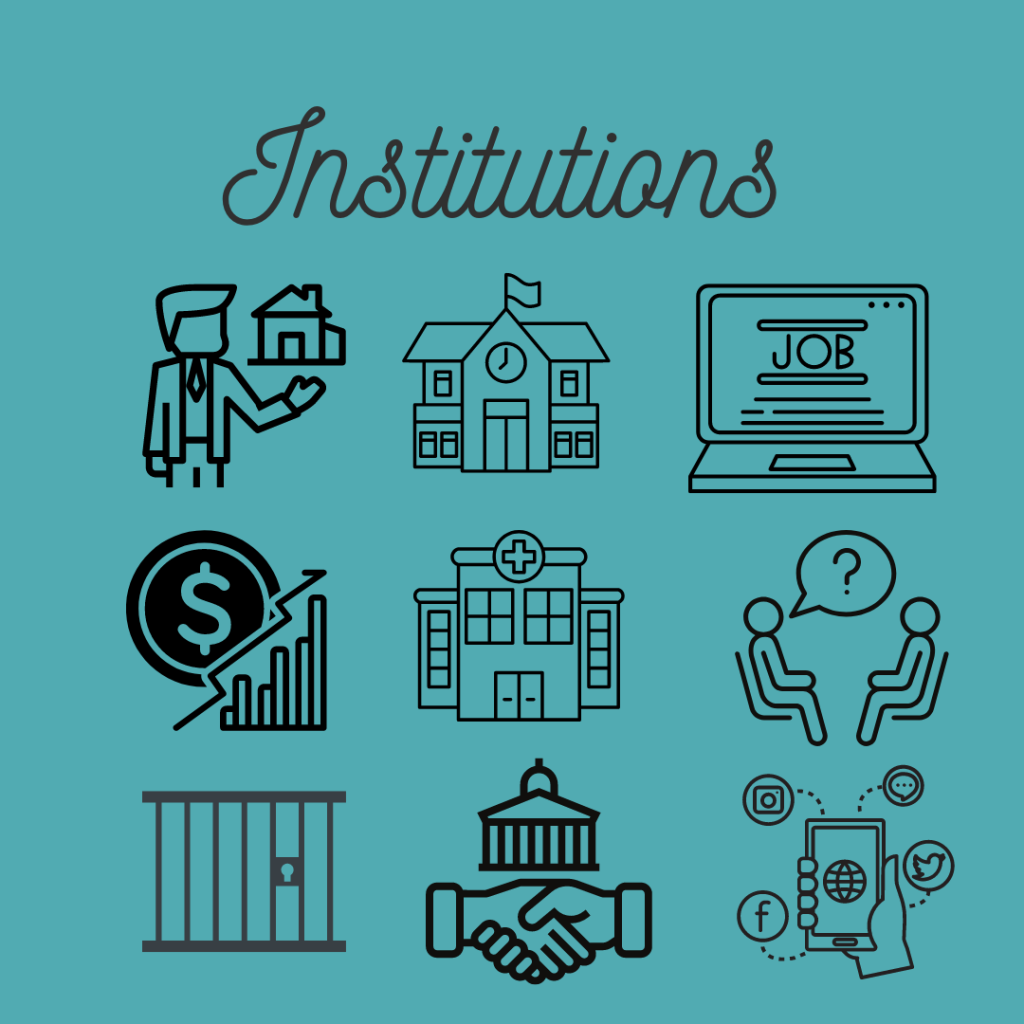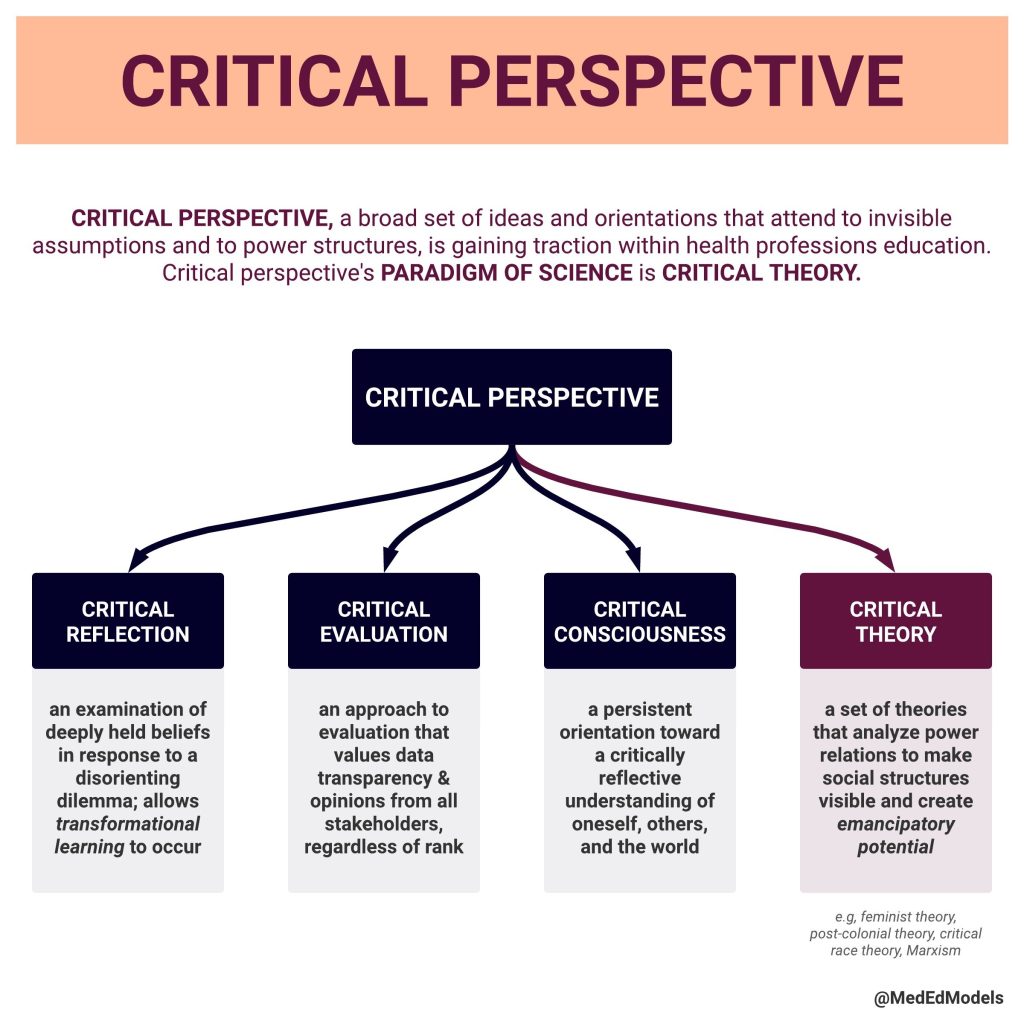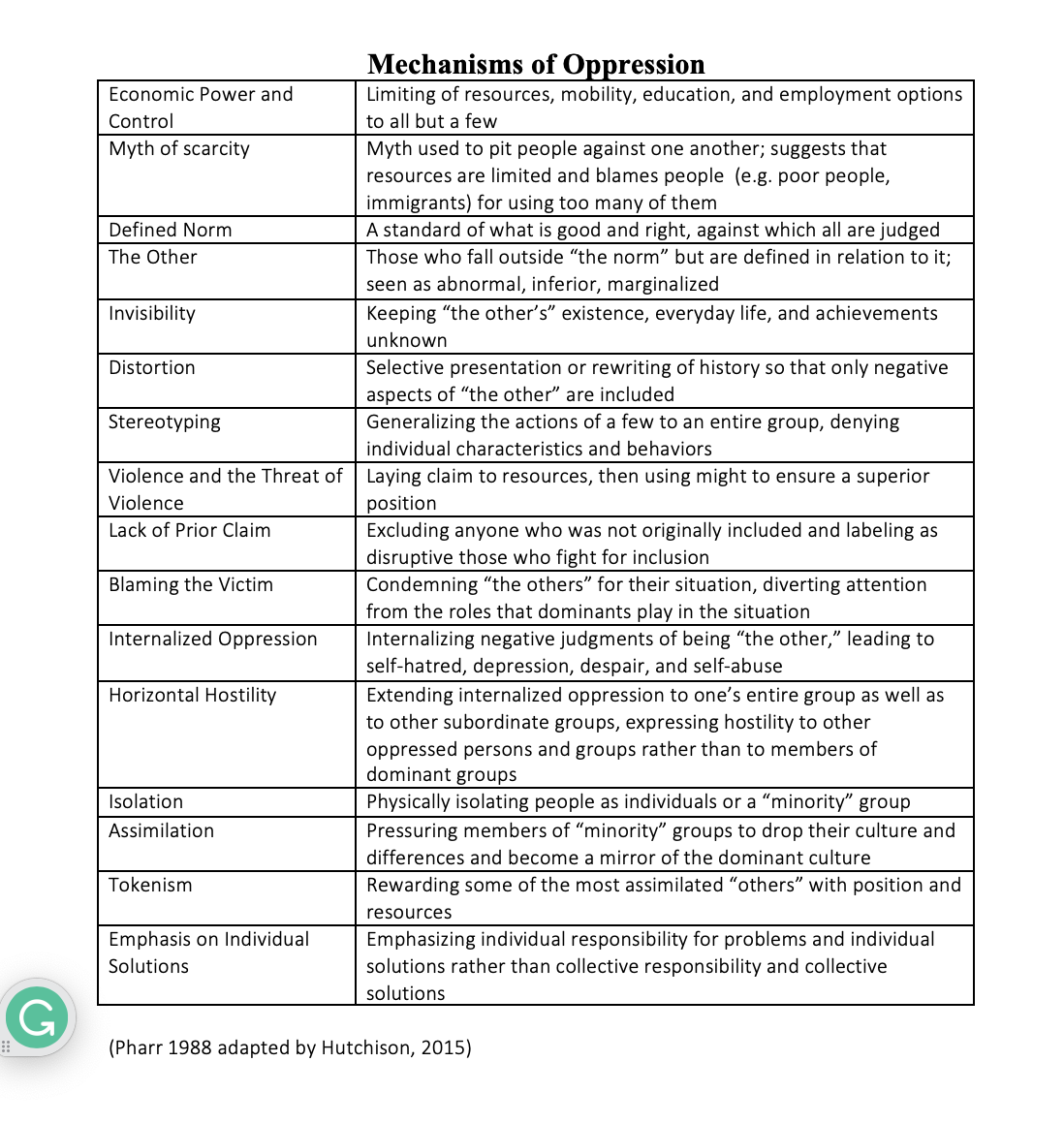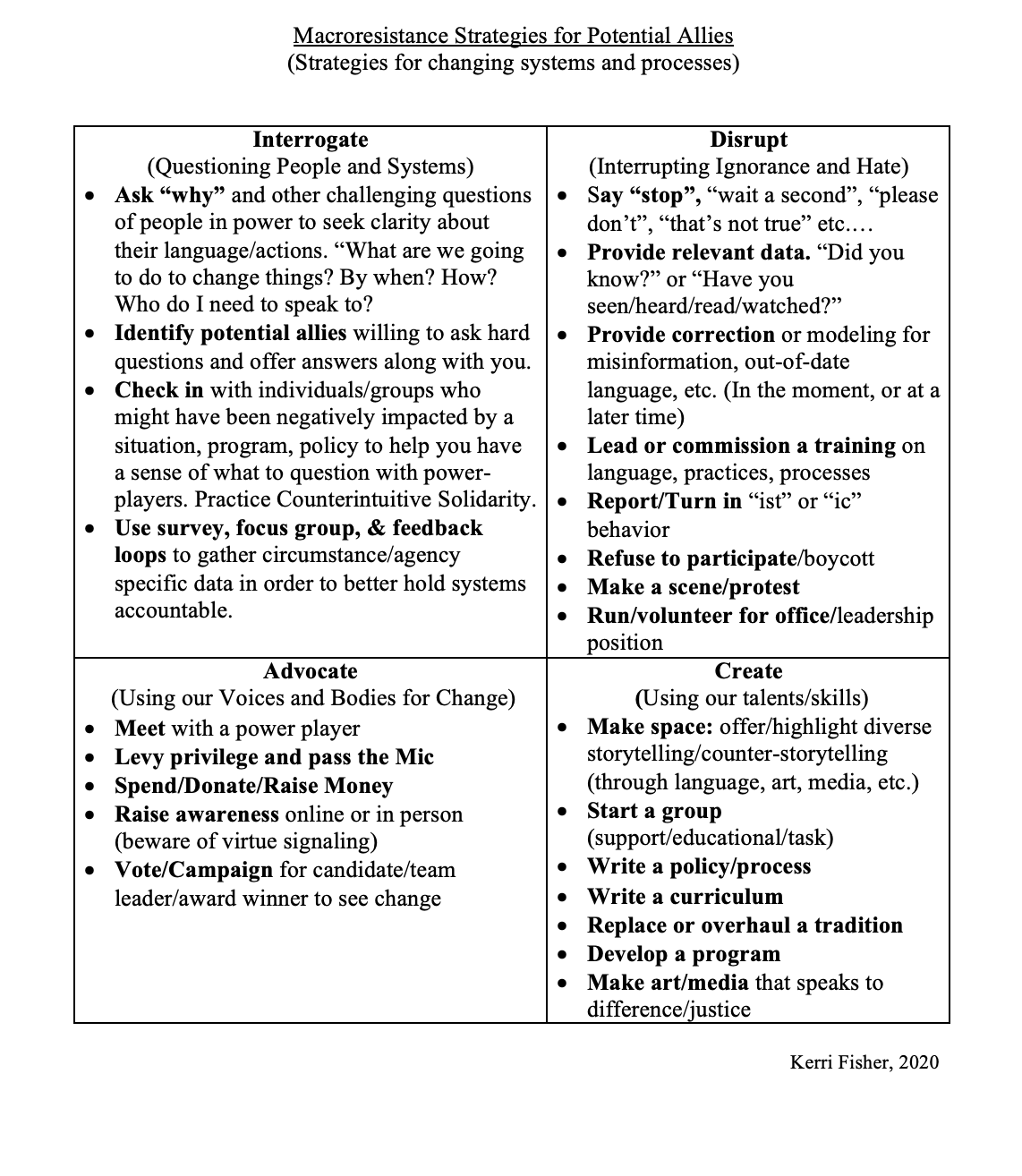Miller, J. & Garran, A.M. (2007) The Web of Institutional Racism, Smith College Studies in Social Work, 77:1, 33-67, DOI: 10.1300/J497v77n01_03
2 Institutional Systems and Macro Considerations for Leaders
Grounding
Think of a time when you first understood that a policy or process was unfair and/or unmanageable for you or someone you care about.
- What do you think were the reasons the policy or process was created or maintained if it wasn’t working for everyone?
- What did you think/feel/say/do at the time that you realized this policy/process was unfair?
- Is there anything you would have wanted to do differently if given another opportunity?

Terminology
Institutions/Institutional Systems: This text will alternate between the terms “institution”, “system”, and “structure” to describe the major cultural entities that create and contribute to the overall life outcomes of individuals from various intersectional identities. Below are nine central institutions in any given society as defined/described by Miller and Garran (2011). Read the definitions and click on the links provided (at least 3) to examine some of the disparities/disproportional outcomes in each area in recent years.
Institutions/Systems:
- Residential System: Programs, policies, and processes that create access and/or barriers to neighborhoods and housing.
- Examples: Opportunity Starts at Home, 2022; National Association of Realtors Apology, 2020
- Educational System: Programs, policies, and processes that create access or barriers to public and private, elementary school, secondary school, and/or higher education
- Examples: Children at Risk Report (Texas), 2023
- Employment/Economics Systems: Programs, policies, and processes that create access or barriers to interviews, hiring, promotion, pay, wealth accumulation, & upward mobility.
- Examples: National Fund for Workforce Solutions, 2022
- Healthcare/Environmental Systems: Programs, policies, and processes that create access or barriers to clean air, insulation from natural disasters, and/or preventative and restorative medical intervention.
- Examples: American Progress, 2020.
- Mental Health System: Programs, policies, and processes that create access and/or barriers to qualified, representative, culturally aware, specialized, therapy, case management, and crisis intervention.
- Examples: Psychiatry.org, 2022
- Carceral System: Programs, policies, and processes that create access and/or barriers to fair sentencing in terms of type, length, and intensity of legal punishment.
- Example: Prison Policy, 2022
- Politics: Programs, policies, and processes that create access and/or barriers to governmental representation.
- Examples: Pew Research, 2022
- Media: Programs, policies, and processes that create access and/or barriers to fair representation in journalism, art, and societal communication.
- Examples: Geena Davis Institute, 2022; GLAAD Report, 2023
Critical Theories
Critical Theories are a group of legal, philosophical, and social frameworks that describe, analyze, and in some instances, challenge the social structures/environments that create power and resources for some and not for others. Critical theories include but are not limited to: Critical Race Theory, LatCrit, AsianCrit, QueerCrit, Feminist/FemCrit, FatCrit, & QuanCrit. Baylor readers find critical research here. Others please see your instructors’ LMS for more articles. The following is a helpful breakdown of the various ways that individuals and communities use the word “critical” to capture a variety of academic understandings.

Sociologist C. Wright Mills believed that “neither the life of an individual nor the history of a society can be understood without understanding both.” He explored the interconnectedness between so-called “private troubles” and “public issues” in his seminal book, The Sociological Imagination (1959). Ten years later, activist Carol Hanisch penned an article titled The Personal is Political (1969) offering a phrase still widely used as a shorthand for one of the central tenets of critical scholarship. No individual or groups experience their lives separate from their external environmental and institutional influences; and institutions are not always designed to provide equitable access for a wide range of individuals and groups.
A student reading an online textbook for class at a private university in the United States of America may well have worked hard at their academics, art, athleticism, or altruism in order to get accepted to the school of their dreams, but the ability to attend college is highly impacted by national educational opportunities and barriers, health opportunities and barriers and legal opportunities and barriers. At the same time that the previously mentioned student is studying for their favorite class, another with similar hopes, aptitude, and character is working at a job to raise money to afford higher education at a later date, while another is sitting with family at the hospital hoping that insurance will cover the necessary expenses, while another is participating in a group therapy session at a state prison. Because various institutions, communities, and nations create their own policies and processes, one tool for creating justice across multiple systems is the Universal Declaration of Human Rights created by representatives of different legal and cultural backgrounds through the United Nations. Check that out here.
How do the definitions, examples, and resources provided above align with your previous understanding of critical theories? In later chapters, we will delve into particular critical theories, but for now take some time to reflect on what you need to do the courageous work of being a strong critical thinker. What has historically helped you to stay both grounded and open when presented with “disorienting dilemmas”? What can you do to set yourself up for success in this and the following chapters if the goals are to labor, to learn, and to expand through both strength and struggle?
Reflections
- What connections did you make to the material in this section?
-
- Connections to other academic learning?
- Connections to your own lived experiences, thoughts, and emotions?
- Connections to current news/pop culture?
2. What questions do you still have about the material in this section?
Elements/Mechanisms of Oppression
Suzanne Pharr first described a collection of oppressive elements in her 1989 book Homophobia: A Weapon of Sexism. Elizabeth Hutchison (2015) later adapted the elements and renamed them “Mechanisms of Oppression”. The sixteen adapted definitions are below.

Take a moment and try to think of an example of each mechanism of oppression in your life or in recent news/popular culture. Which do you feel most comfortable explaining to someone else? Which if, any are still a bit confusing? The author of this text has created four categories of macroresistance that self-advocates and aspiring allies can use to intervene in systems where mechanisms of oppression are being used to create and/or continue inequity.

Looking at the chart above, how many of these resistance strategies have you tried? Which of them seems the most natural to you? Which could be a “comfortably uncomfortable” opportunity for you to try in the future?
Reflections
- What connections did you make to the material in this section?
-
- Connections to other academic learning?
- Connections to your own lived experiences, thoughts, and emotions?
- Connections to current news/pop culture?
2. What questions do you still have about the material in this section?
References
Daftary, A. M. H. (2018). Critical race theory: An effective framework for social work research. Journal of Ethnic &
Cultural Diversity in Social Work, 29(9), 439-454. https://doi.org/10.1080/15313204.2018.1534223
Fisher, K. (2021). An experiential model for cultivating cultural humility and embodying antiracist action in and outside the social work classroom. Advances in Social Work 21(2/3), 690-707. https://doi.org/10.18060/24184
Pharr, S. (1988). Homophobia: A weapon of sexism. Chardon Press.